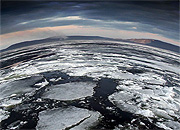Today it is a privatized company but the Norwegian government still holds a majority of the stock in the company. It is my understanding as well that Statoil is the last of the three Norwegian oil/gas production companies established by Norwegian government policy in the early 1970’s to develop their oil and gas resources in their sector of the North Sea. As such it is the ‘flagship’ oil company of Norway and responsible for the development of Norwegian oil and gas resources, which are quite substantial.
My question is this: If Statoil were to be involved in a major blowout incident in the Arctic that was beyond the capacity of the company to deal with financially, is the Norwegian government, the majority shareholder, on the hook for the balance of any cleanup costs? I bet nobody has an answer for that question.
Shell is a completely independent company. Statoil is not. It seems to me that if Statoil is ever involved in a major incident, like BP’s or some of Shell’s past incidents, there is the possibility of a serious diplomatic ‘dustup’ over cleanup costs and the manner in which the company deals with the situation.
And how would the Norwegian government deal with a situation where an incident and the subsequent financial burden of cleanup threatened the long term financial stability of that country’s ‘flagship’ oil company?
It seems to me the US government is sailing into uncharted diplomatic waters when it allows state-controlled oil companies to explore and produce in US territorial waters. There are issues here that need to be resolved. It is also readily apparent that the Dept. of the Interior and MMS are in over their heads on these matters. Perhaps it is time to seek some competent and professional assistance from the US State Dept.
I would presume however, that when it comes to operating in the cold, difficult environment of the Arctic it is Statoil that has far greater technical and managerial competence than Shell Oil USA, which has never operated a production project in the Arctic, and is mostly a Gulf of Mexico based company. In fact, it is a good bet Statoil’s competence exceeds that of BP and Exxon. So, perhaps Statoil is actually the preferred operating company in US Arctic waters. Shell, et al, could probably learn a thing or two from Statoil.
It also seems to me that the only oil companies that should be allowed to operate in Arctic regions are the ‘majors’, simply because only they have the financial where-with-all to deal with a major accident and its aftermath.
And it also seems that the oil industry should be required to establish an ‘incident/accident’ fund of several billion dollars, similar to that being contemplated in the Gulf of Mexico (to great public fanfare). All operators would contribute to this fund. This fund would insure that there would be readily available financial resources to react immediately to a major ‘Arctic environment incident’. The oil industry has never operated accident/incident free anywhere in the world, and they most certainly haven’t been able to do so in the Alaskan Arctic. There will be a major offshore incident if production is allowed in the Arctic. So, it seems that a ‘damage control’ plan should be established and funded prior to development, and prior to the ‘incident’. If these companies have billions to spend on leases they most certainly have the cash to contribute to the establishment of such a contingency fund.
"The Wall Street Journal"
24 Декабря 2025 | среда | 13:05


